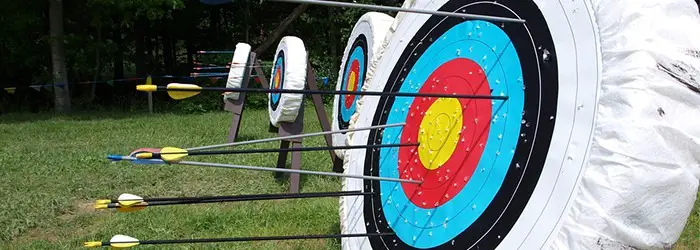This might’ve happened to you, where you take what you feel is the perfect shot, only to lower your bow and see that you’ve hit low. This can be quite discouraging, and that’s why I’ve researched the topic to find the top reasons why your arrows might land too low. I’ll share them in this concise post.
There are a few reasons why your shots might be consistently low. Most commonly, your shooting gear might be out of tune. Your shooting form or shot sequence might be off, or the environment can cause low arrows.
These reasons might cause your shot to be consistently off, and can deflect your arrows downwards. In this post, we’re going to explore the different causes your shot might be low, and how to fix every one of them.
Reasons why your arrows might go low
Let’s define some basic things first. What we’re interested in when we’re discussing a consistently low shot, is the center of your arrow groups.
If you shot a tight group around the center, and have one arrow that’s off, it’s only a matter of human error. When discussing consistent offsets, we’re trying to center your groups.
Now, if your shots are off and you’ve handled bows before, you’ll probably be able to feel rather quickly that something is off.
If your groups aren’t very tight, you might want to record the location of the center of your groups, and see over time if it’s consistently low. You’ll also want to work on making your groups tighter, I’d suggest going about it by first considering your bow stability. You can learn more about holding your bow more steadily in my post about the subject.
Now that you’re sure that you have a persistent offset, let’s split the types of issues that might cause your arrows to go low into 3 categories:
- Out-of-tune gear
- Shooting form issues
- Environment causes
Now, each of these categories has multiple different issues that might cause the offset. We’ll use a process of elimination to determine what’s causing the issue.
Some are really easy and simple to fix, like, for example, small gear tuning you might be able to do in an afternoon. Others will require that you improve your shooting form, which might take a while.
If you’re new to archery and using proper gear in a controlled environment, you’ll probably want to pay close attention to your shooting form.
It’s actually a great time to improve your shooting form, because you haven’t got used to bad ways of shooting, so you can develop better habits and make them stick.
If you’re more experienced and suddenly you noticed that your shots are off, it’s most likely your gear or the environment.
Some of the reasons your arrows are landing low, might also cause your arrows to go off to the side. In a recent post I wrote, I specifically detailed why your arrows might go left or right. If you also have that problem, I suggest reading that post as well.
The environment is easier to control, and if you see this consistently low arrows over days, it’s probably your gear. I have a few things here you should check if you’re suspecting it’s your gear.
Check your gear
I’ll urge you to check whether your gear is properly tuned. Especially if the low shooting began suddenly, it’s really likely that it’s a result of some part of your gear going out of tune.
There are a lot of things that might cause your arrows to land low. I’m going to list some examples you’re going to be able to check for yourself. If you’re not comfortable handling that, or you weren’t able to find the issues, I suggest you go to a pro shop to have your bow tuned.
Parts that might go out of tune and cause your arrows to go low:
- arrow rest: if your arrow rest moved it might cause your arrows to go lower. Make sure that your rest is tuned, that it drops when needed, and that it didn’t accidentally move. This is one of the most common causes of this issue.
- cables: the cables on a compound bow get stretched over time, and affect the timing of the bow. Compound bows have timing marks on the cams, and if they’re off the cables might be the issue.
- peep-nock-sight alignment: a misaligned peep, nock or sight can easily cause your arrows to go low. By moving, they can cause the image you see through the sight to not be aligned with the path of your arrows.
To solve this issue, you should tune and align all the different parts of your bow.
If you need to adjust your sight and want to do it yourself, I have a whole guide on how to level a bow sight. The process there can help you properly tune your sight.
Check your shooting form
The next thing that should be checked is your shooting form. There are multiple different things that can cause your arrows to go low, and I’m going to detail some of them here.
If your shooting form is the issue, it’ll take some time to fix it. You’ll need to break bad habits and work against your muscle memory to develop new and better habits. But working on your form will eventually result in better accuracy, and better consistency (your shots will be closer to the center, but also grouped better).
With that in mind, you should ask yourself a few questions regarding your shooting form.
Are you properly following through?
The first thing you should check is whether or not you’re following through with the shot. If you don’t wait enough time for the arrow to leave the bow and lower it, you might deflect it.
Commonly, not following through is manifested as arrows hitting low in the target.
The standard way to make sure you’re following through is to wait until you hear the arrow hit the target before you lower the bow to look at where it landed. This will ensure that you don’t affect the path of the arrow.
It might be a bit tough to delay the urge to look at the arrow, but following through is really important.
If you try this tip and see that your arrows now hit closer to the center of the target, it might be the issue you’re facing.
Did you change your anchor point?
Failing to properly anchor can manifest in many different ways, including inconsistent shots and consistent grouping away from the center. I suggest you check your anchoring if you’re having this issue.
The process of anchoring is really important for consistency with archery. To anchor means to pull the bow to the exact same location every time you shoot, typically by pulling your drawing hand or the bowstring to some location on your face.
Standard anchor points are the hand to the jawbone, the hand to the cheek, or the bowstring to the nose. It doesn’t really matter what’s your anchor point, only that it’s consistent.
Archers that don’t anchor properly will typically have a hard time grouping, but that doesn’t explain consistently low arrows.
What’s important to consider is if you’ve changed your anchor point, that might create these consistently low shots. When you change your anchor you should adjust your sight, nock, and peep to be centered with your now anchor point.
Learn more about proper anchoring in my post about proper shot sequence. I’ve detailed how to find your anchor point, and other useful tips for a good shot sequence.
Is your distance judging off?
If you’re shooting without distance markers and using your distance judging, you might find that if your distance estimation is consistently off, you might have consistent low or high shots.
If you judge the target to be closer to you than it really is, your arrows will land low. In the opposite case where you judge the target to be too far, your arrows will typically land high.
I say “typically” because the path of the arrow is a bit ballistic, meaning that it first rises then falls. If the target is far enough from you, that’ll be the case.
In any case, checking whether your distance judging is off is pretty easy. First, try shooting at a marked range, and see whether your shots are still low. If not, it’s probably your distance judging, in which case – you should work to improve that skill.
You can also play the “distance judging game”, where you place yourself in the range, judging the distance to the target and then confirm it with a rangefinder. If you’re consistently off, it might be your problem.
If you need some more guidance with yardage judging, you’ll find my distance judging post really useful. I included some great tips and exercises you may use to sharpen your skills.
Consider your environment
When thinking about your environment, you should think about a few things: height difference and wind.
The previous section is a good segway to considering the height difference between you and the target when shooting your bow.
The issue, which is unlikely to rise in a standard range, but should be considered, is that your distance judging will be off when shooting uphill or downhill.
If you shoot uphill the same way your shooting in a plane range, your arrows will be consistently low. Your shots will be high when shooting downwards.
There are rangefinders that do take height difference into account, but doing it yourself can be quite challenging.
Even if you know the exact air fly distance between you and the target, the fact that you’re shooting at an angle should be taken into account in the aiming angle calculation, which is quite hard for non-experienced archers.
That’s why shooting from a treestand is challenging and requires practice, though shots from a treestand will typically land high and not low.
Another thing that might affect the precision of your shots is the wind. If you’re shooting outdoors in a windy area, your shots might be consistently off.
Of course, over multiple days it’s unlikely that wind will deflect your arrows in the same direction. That’s why the best way to check whether the wind is the problem is by shooting over multiple days and checking your precision over time.
Conclusions
Consistent low shooting can be quite a tough problem to solve, mainly because archery is a complex process with multiple different parts. By splitting it into different categories and checking them in an organized process, you’re very likely to find the issue and solve it.
We’ve discussed multiple reasons why your shots might be low, including gear tuning issues, bad shot posture, and environmental causes. Of course, each of these categories might have many other issues that we didn’t consider to explore here.
If you’ve followed this post and wasn’t able to find the issue, I’d suggest going to a pro-shop to tune your bow, and having a professional archery coach have a look at your shooting form. You might benefit a lot from that.
An additional post worth reading discusses what to do if your shots go off to the side. You’ll find some great tips to eliminate this issue, if you face it as well.
In any case, I hope this post was helpful, and that you were able to find those issues that cause your arrows to go low. Good luck and have fun shooting!



